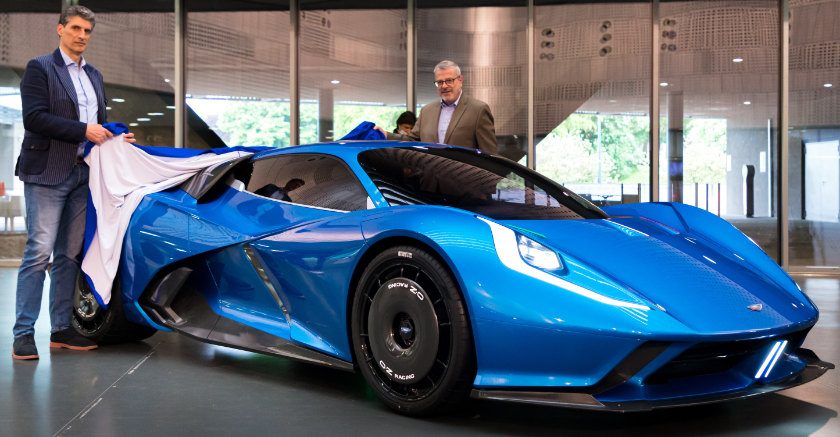
LIVING A private collector commissioned Lamborghini to re-create its 1971 Countach LP500 show car, the purest expression of the company’s dramatic wedges that underlies even its current DNA. Jack Yan looks at its design history and the cultural impact of the Countach
From issue 44 of Lucire





Lamborghini
The Lamborghini Countach is the stuff of dreams, especially if you’re now middle-aged and can remember posters of the archetypal 1980s version—the LP500S—being widely available. As teenagers we’d wonder what was the fastest production car in the world, and the bespoilered, beetle-doored Countach LP500S stirred our imaginations as Lamborghini claimed it, and various publications confirmed it.
Even if it had been the Countach’s arch-rival, the Ferrari 512 BB, we’d probably still have been captivated by the Lambo. When the 25th anniversary model arrived at the end of the Countach’s life, it seemed like a reasonable update. But what we dreamers didn’t know was how it wasn’t the most comfortable car to drive, but then again, it’s a supercar, a car which Marcello Gandini, the designer behind its wedge-shaped styling, called a dreamer’s car with no compromises. Practicality was a compromise, and when Lamborghini tried to replace it, with Chrysler interference, it got the Diablo, which never had the purity of design.
The LP500S wasn’t, however, the Countach many of us first saw. Matchbox produced its no. 27 in the early 1970s, a much simpler shape. We weren’t old enough to have seen it at Genève in 1971, where the full-sized one débuted. Finished in giallo fly speciale, it would have looked not only ultra-modern, with its razor-sharp lines clothing its mid-engined layout, but it would have seemed a dream car. The fact it was poised to succeed the curvy Miura and bring Lamborghini into the 1970s would have been something to take in.
It’s only now that I’m older that I see the beauty behind the original show car of 1971. It does away with all the ducts and spoilers that spoiled Gandini’s (while at Italian styling house Bertone) original vision for the Countach. Here you can see the wedge, but, more importantly, the design statement that is so in tune with the era, a belief that pure, unadorned, straight forms convey modernity and the success of industrial design. No more beating shapes into curves when straight lines express volume and a simplicity of line. The fact the Countach appeared impossibly low only served to make it more astonishing—a contrast to the other 1971 débutante from Italy, the Fiat 130 Coupé. There Pininfarina worked with the straight line for volume, both to make the 130 Coupé look imposing and to maximize the interior cell.
This is, of course, a simplified explanation. Look more closely at the Countach and there are curves, bulging ever so slightly over each wheel. There’s a dramatic rise from the low front bumper over the front wheels, giving the Countach a shorter nose—which happens to contribute to the appearance that it’s ready to pounce into action. That curve gently rises to the rear wings. The straight lines are in the front windscreen, the glasshouse and the roof, not to mention the dramatic cut in the rear wheelarches, a Gandini signature that would appear on some of his later work. The rear end continues the theme of the front, with another dramatic rise to the rear light cluster, ensuring the overhang remains short.
Modernist details abound: the asymmetric nose, with the Countach script on the left, looking futuristic as it reinterpreted the “computer”-inspired type of the mid-1960s and on; and a series of 15 vertical slots to the right. Lamborghini had not envisaged the need for big protruding ducts to cool the engine, so the original Countach makes do with six strakes aft of the front windows to bring air in. There is no side intake, keeping the shape pure. The rear echoes the front with its asymmetric badging and simple lights; its four tailpipes pointing upwards as a statement that they are there, while also highlighting the recess in the tail section that contributes to the Countach’s pert rear end. Similarly, the interior is a modernist statement, with three simple rectangular blocks forming the padding on the steering wheel, and blocks of colour for its diagnostics; it was certainly more of a statement than what went into series production in 1974.
continued below









Period details unique to the 1971 show car were painstakingly re-created with computer analysis and traditional construction
Sadly, the original Countach prototype was destroyed in crash tests in 1974 and disappeared, but that did not stop one collector commissioning a re-creation of the car, built by Lamborghini’s Polo Storico division.
Giuliano Cassatoro at Polo Storico spent the first months just gathering material, including getting the memories of those who were involved in the creation of the original, along with photographs, drawings, reports and other documents.
The car’s size came from 3-D scanning the chassis of the first LP400 (chassis 001) but the chassis itself is unique, different to the tubular frame of the production models. Modern techniques were used to analyse the body, with Lamborghini Centro Stile under head of design Mitja Borkert developing a 1:1 styling model, spending 2,000 hours getting the lines right. The body then was ultimately made the traditional way by the battilastra. The interior followed the same process.
This was a massive effort requiring 25,000 hours of work since the original commission in 2017, right down to re-creating the tyres which have the same tread as the 1971 Pirelli Cinturato CN12s that the show car wore. The compounds may be modern, but they look like the original tyres.
The tyres also contribute to the original car’s stance, with their larger sizes: 40 mm more at the front and 50 mm more at the rear, compared with the 1974 LP400 production car.
The colour was replicated after studying Polo Storico’s archives. Genuine parts were used, some were restored, and others were built from scratch.
The beauty of the re-creation is that it works. Lamborghini took the finished car to the Vizzola Ticino race track, in the presence of the collector and participating suppliers. It was also the official presentation of the car to its owner, who took his new pride and joy around the circuit.
The car will be on display through November 15 at the Mudetec Museum in Sant’Agata Bolognese, alongside a bare LP400 chassis, the second production car, and a later Countach 5000 QV. •
Jack Yan is founder and publisher of Lucire.





Original 1971 photos




Related articles hand-picked by our editors

Enriching alternatives
An electric car with over 2,000 PS; a honey replacement; and familiar names moving upmarket mark out this month’s lifestyle products of distinction

Weight: a moment
The US car industry’s design excesses of the 1970s had their roots somewhere, mirroring what was happening in fashion. Jack Yan thinks they emerged during more optimistic times and history may be repeating

With the cares of the world far behind us
With a 50th anniversary limited edition based around its potent V12 DBS Superleggera, Aston Martin pays tribute to a Bond car, one that isn’t as well known as the DB5 from Goldfinger, but which deserves to be considered alongside it, says Jack Yan
Photographed by Dominic Fraser and courtesy Aston Martin